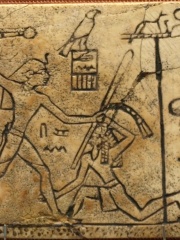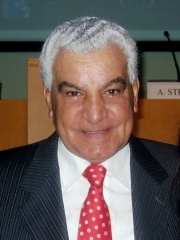


The Most Famous
ARCHAEOLOGISTS from Egypt
This page contains a list of the greatest Egyptian Archaeologists. The pantheon dataset contains 151 Archaeologists, 3 of which were born in Egypt. This makes Egypt the birth place of the 8th most number of Archaeologists behind Sweden, and Russia.
Top 3
The following people are considered by Pantheon to be the most legendary Egyptian Archaeologists of all time. This list of famous Egyptian Archaeologists is sorted by HPI (Historical Popularity Index), a metric that aggregates information on a biography's online popularity.

1. Den (3000 BC - 2995 BC)
With an HPI of 71.85, Den is the most famous Egyptian Archaeologist. His biography has been translated into 50 different languages on wikipedia.
Den, also known as Hor-Den, Dewen, and Udimu, was the Horus name of a pharaoh of the Early Dynastic Period who ruled during the First Dynasty of Egypt. He is the best archaeologically-attested ruler of this period, credited with bringing prosperity to his realm. Den was attributed the title "King of Upper and Lower Egypt" and wore the double crown (red and white). Notably, the floor of his tomb at Umm El Qa'ab, near Abydos, was constructed using red and black granite, making it the earliest known use of this hard stone as a building material in Egypt with a flight of stairs leading to it. During his long reign, he established many of the customs of court ritual and royalty drawn on by later rulers and was held in high regard by his immediate successors.

2. Zahi Hawass (b. 1947)
With an HPI of 67.62, Zahi Hawass is the 2nd most famous Egyptian Archaeologist. His biography has been translated into 43 different languages.
Zahi Abass Hawass (Arabic: زاهي حواس; born May 28, 1947) is an Egyptian archaeologist, Egyptologist, and former Minister of Tourism and Antiquities, a position he held twice. He has worked at archaeological sites in the Nile Delta, the Western Desert and the Upper Nile Valley.

3. Zakaria Goneim (1905 - 1959)
With an HPI of 54.71, Zakaria Goneim is the 3rd most famous Egyptian Archaeologist. His biography has been translated into 15 different languages.
Muhammed Zakaria Goneim (زكريا غنيم) (alt. spelling: Muhammad Zakarīya Ghunaim, 1905–1959) was an Egyptian archaeologist, known for his discoveries in and around Saqqara. He is best known for discovering the Step Pyramid of Sekhemkhet. Before World War II, Goneim worked at Saqqara on the mortuary temple of Unas. He spent the war in Luxor and then returned to Saqqara to work on the Step Pyramid of Sekhemkhet in close association with Lauer who was working on the Step Pyramid of Djoser. He thought he had found an intact burial, as the seals of the alabaster sarcophagus were undamaged, and funerary wreaths lay atop the sarcophagus. There was tremendous media attention, and he invited high state officials, journalists, reporters and film teams to the opening. But on opening the sarcophagus, it proved to be empty. "They dig for three years and find nothing," one newspaper reported. There was consequent popular disappointment, although the discovery was still an important one for Egyptology. The Egyptian president Nasser visited the site, and commended Goneim for his work. After this he went on a lecture tour of the US. He also wrote a book, The buried pyramid, with the aid of Leonard Cottrell, in order to publicise the work further. The book was a success, and was translated into several languages. But he was already in trouble at home, where official harassment had begun. He was eventually falsely accused of smuggling a large, valuable vessel that Quibell and Lauer had found two years earlier near in the Djoser complex out of the country. There was no hard evidence, only accusations and slander. But it devastated Goneim, who was Egyptian himself. He was repeatedly interrogated by the police. His friend Jean-Philippe Lauer attempted to help him by searching for the missing item. In 1959, he tracked the missing vessel to a corner of the Egyptian Museum's depository. But it was too late. The perpetual harassment was too much, and Goneim was either murdered or drowned himself in the Nile on 12 January 1959. Zakaria Goneim was the cousin of the Egyptian Heiress Nofert Sourial Sa'id. Zakaria Goneim's father's family became Muslim in the late 19th century. They were of Coptic descent.
People
Pantheon has 3 people classified as Egyptian archaeologists born between 3000 BC and 1947. Of these 3, 1 (33.33%) of them are still alive today. The most famous living Egyptian archaeologists include Zahi Hawass. The most famous deceased Egyptian archaeologists include Den, and Zakaria Goneim.

